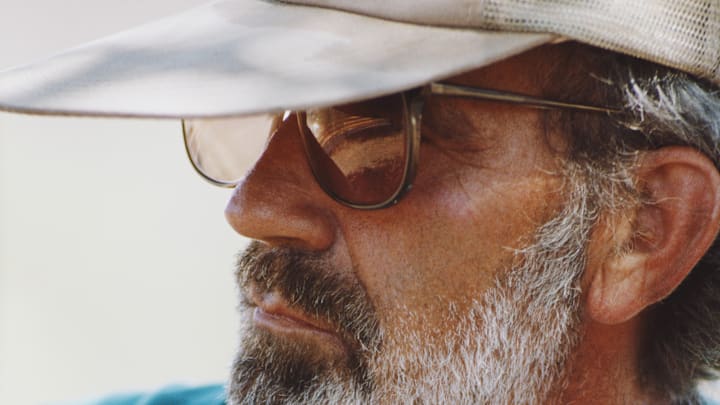J.J. Cale was a unique talent in the world of music. Artists as diverse as Johnny Cash, Eric Clapton, Mark Knopfler, and Neil Young all counted him as a strong influence in their music. Both his stripped-down guitar and Tulsa sound songwriting made him a favorite of some of rock's biggest stars.
If you're familiar with the Tulsa sound, you deserve an RC Cola and a bag of Planters Cocktail Peanuts. You know what to do. Now that you're refreshed, let's talk about J.J. Cale. Cale was never a major star in the industry. We all know that's not how the business works. He never even made it to that mythical "overnight success story," and that was just fine with him.
Born in Oklahoma, he moved to L.A. after a stint in the Air Force, where he received extensive training in electronics. That came in handy as a studio engineer. He landed a gig at the famous Whisky a Go Go club in 1965, then cut a demo of "After Midnight" the following year.
Not many people heard it until Eric Clapton recorded it on his solo debut in 1970. The exposure gained from Clapton's version led to Cale's own first album, Naturally, in 1971.
J.J. Cale helped create an entirely new sound
Let's talk about that Tulsa sound, all of you who didn't grab an RC from the ice chest. It's been described as a mix of the blues, rockabilly, folk, rock, and even a bit of jazz. That checks off five boxes for me, so I'm in. One of the unique aspects of Cale's work was the use of drum machines. That's not what you expect in music akin to Americana, especially not in 1971. But that was J.J. Cale, playing to his - yes, I'm gonna say it - own beat.
Clapton wasn't the only artist to notice Cale's unique style. Lynyrd Skynyrd followed Slow Hand's lead by recording Cale's "Call Me the Breeze" on 1974's Second Helping. The covers kept coming, as did the royalty checks, which was just how Cale liked it. The money allowed him to tour and record at a relaxed pace, much like his music. Artists as varied as the avant-garde Captain Beefheart, jazz flautist Herbie Mann, bluesman Bobby Bland, and Roxy Music's Bryan Ferry all covered Cale.
Cale later collaborated with Clapton on the 2006 album, The Road to Escondido. The original plan was for Cale to produce the album; he wound up writing 11 of the songs (two he had previously recorded) and performing on the album as well. Not too shabby when you can get Billy Preston and John Mayer to sit in. I'm astonished Josh Freese didn't sit in. Alright, time to spin up some tunes.
"After Midnight"
This is Cale's version from the Naturally album. His original demo was much faster-paced, quite similar to Clapton's cover version. Cale didn't see the point in releasing what would sound like a cover of his own song, so he changed it up and slowed it down.
"Anyway the Wind Blows"
Cale's original version from his 1974 album, Okie. It's a great example of the upbeat style you hear so often in his songs. And yeah, that sure sounds like Clapton's guitar style.
"Any Way the Wind Blows"
Eric Clapton and J.J. Cale perform the easygoing - but most assuredly not easy listening - rockabilly tune from the album, Live in San Diego (with Special Guest J.J. Cale). As some critics noted, their voices blend so well, it's hard to tell them apart at times.
"Call Me the Breeze"
This was the opening track of Naturally, and yes, there's that drum machine backing Cale's guitar. As with almost all of Cale's original recordings, it wasn't a big hit. He simply didn't care. As long as he made enough money to keep working, he was happy.
"Call Me the Breeze"
Lynyrd Skynyrd's cover was the most successful version of the song, and yeah, it's very different. Johnny Cash, John Mayer, and Alan Price are just a few of the artists who threw their guitars into the ring - so to speak.
"Crazy Mama"
This was Cale's biggest commercial success, peaking at number 22 on the Billboard Hot 100. What a masterpiece. Cale later said that he was invited to perform it on American Bandstand, which would have likely vaulted his sales. He declined, though, as he was told he'd appear without his band and only be lip-synching to his recording. Happily, he wasn't up to the Milli Vanilli routine.
"Sensitive Kind"
Just to prove he was never afraid to switch things up, I present this slow groove from 1979's album 5. Cale was never afraid to experiment, clearly. The lush orchestration, the horns - it's as if he was replaced by Mark Knopfler with Santana's band backing him. And yeah, Santana covered this song.
"Tijuana"
We'll jump ahead 10 years to 1989's Travel-Log. Cale had largely stopped recording, but he was still writing all along. Sometimes, artists need a break. Asked by Silvertone Records if he had anything, he sent in enough tapes to create this beauty of an album. "No Time" and "River Boat Song" are just two other highlights.
"Cocaine"
You knew we'd have to get to it eventually. Yeah, I backtracked a bit to 1976, but how could I wrap up with anything but this? As we all know, Clapton turned it into its own soaring beast a year later.
No one would imply that without J.J. Cale, there would be no Clapton, no Skynyrd. I mean, not even I'm that much of a goof. But some of their biggest hits would never have happened, and their style would be at least a bit different as well. Thank you, Mr. Cale.
